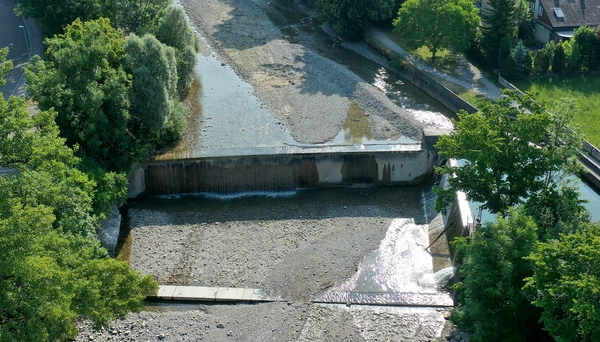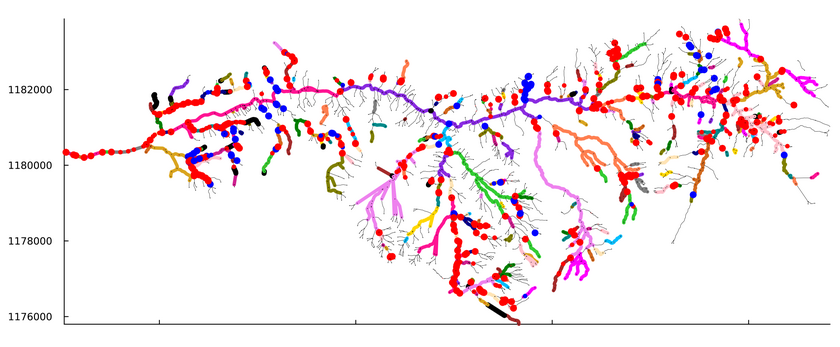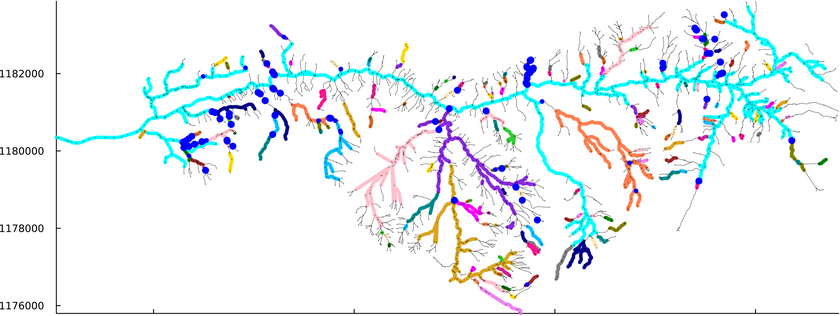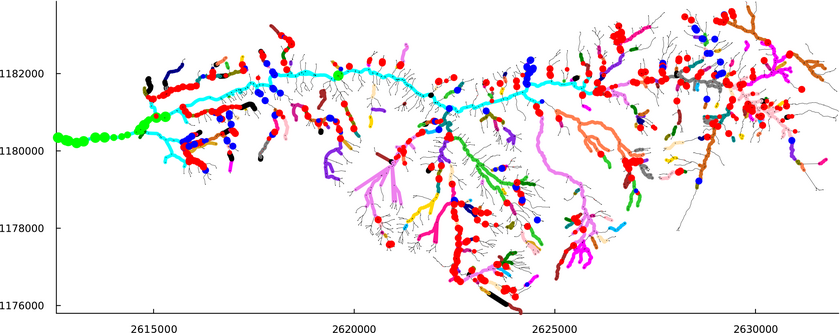News Detail
Improving fish migration with new concepts
March 7, 2024 |
The Water Protection Act, which was revised by Parliament in 2011, is considered progressive by international standards. Among other things, it forms the basis of an 80-year rehabilitation programme for Swiss watercourses and lakes. The goal is to make bodies of water as natural as possible. Dams, weirs, sills and ramps in rivers and streams stand in the way of this requirement, hindering or preventing fish migration. According to the Federal Office for the Environment (FOEN), there are more than 100,000 artificial barriers for fish and other living organisms in Switzerland.
The Water Protection Act obliges the cantons to implement restoration measures in their bodies of water. The cantons decide how this is to be done in their strategic rehabilitation plans, which must be updated by 2026. “There have been tools available for these plans for some time, but the federal authorities had realised that additions relating to connectivity along watercourses would be very useful,” says Peter Reichert. The specialist in modelling techniques and systems analysis of aquatic systems conducted research for decades at the aquatic research institute Eawag and was professor at the ETH Zurich. He retired in 2022, but is still actively involved in research. For example, on behalf of FOEN, he led the development of the procedures outlined in this article for “Prioritising the removal of artificial fish migration barriers in watercourse systems”. Barriers due to hydroelectric power plants are not taken into account in this procedure. These are addressed in other guidelines.
The process is explained in detail in a FOEN report, a summary of which has just been published in the specialist journal “Aqua & Gas”. This method was developed by an interdisciplinary team that included Eawag researchers as well as representatives of the FOEN, cantonal environmental authorities and consultancy firms. In addition, other experts were consulted regarding the methods and criteria that were discussed.
Example of a rehabilitation variant for the River Zulg, a tributary of the River Aare near Thun, which was created on the basis of a fragmentation analysis. Top: current condition; centre: near-natural condition without artificial obstacles; below: a rehabilitation option. The comparison shows that the rehabilitation of the obstacles marked in light green can create connected regions, most of them in the lower section, but also a connection between two larger regions in the middle section.
Colour coding and key: The colours of the broad lines show connected regions for salmonids. The region that can be reached from the underlying body of water (the River Aare) is shown in turquoise. Culverted stretches are marked in black. Narrow black lines are stretches of watercourses that are too steep for salmonids. Dots mark barriers (size depends on the height of the obstacle): artificial barriers are shown in red, natural barriers in blue and, in the rehabilitation proposal under consideration here, barriers to be made passable by fish in green.
The axes show the coordinates according to the Swiss coordinate system.
Setting priorities in rehabilitation
The new method is based on what are known as connectivity or fragmentation analyses. “If you take a close look at the river network in this way,” explains Nele Schuwirth, “you can see what the connected fish regions currently look like, what they would look like in a near-natural state and how they could be enlarged by rehabilitating selected barriers.” Nele Schuwirth heads the Department of Systems Analysis, Integrated Assessment and Modelling at Eawag and conducts research on ecological modelling and assessment.
Thanks to this information, the cantonal environmental authorities can decide where to prioritise the rehabilitation of barriers to fish migration. As the case studies used to test the method show, the potential benefits for fish communities are particularly great when the rehabilitation of barriers can improve the connectivity of tributaries with a main river. Or when large connected regions that are already in good condition or which are to be restored can be linked together.
Looking beyond cantonal borders
Prioritisation is carried out with the intention of selecting barriers to be rehabilitated in such a way that the largest possible connected river systems in which fish can move unhindered, can be created with as little effort as possible. The developers of the new procedure emphasise that this goal can only be achieved if we look beyond cantonal borders and take a “catchment-oriented approach”. The decisive factor here is the overview of all connected regions in the current and the near-natural state.
Specifically, the prioritisation process consists of seven steps. They range from the definition of the catchment to the fragmentation analysis of the catchment and the identification of “key barriers” to reduce fragmentation. Rehabilitation options are then developed, the benefits of these options quantified and their costs estimated. In a further step, the cost-benefit ratio of the variants is evaluated with regard to the entire catchment. This is followed by a provisional pre-selection, and finally experts with local knowledge are called in to make a definite selection of the barriers to be removed.
“Fishery experts with local knowledge are needed to assess the ecological significance of the river sections for the fish,” explains Nele Schuwirth, “and they know from practical experience whether barriers can be passed by fish or not.” This reality check is important, as an assessment based solely on existing data does not allow a definite judgement of the fish migration potential.
Additional effort is kept within limits
A good data basis provides the foundation for prioritisation. Various aspects of a river network must be available in a geographic information system (GIS). For each stretch of the watercourse to be analysed, an ecomorphological assessment is required that shows how far the body of water is from its natural state and where there are barriers to fish migration. Moreover, information must be available on whether a river or stream is culverted and whether it flows through a settlement area or not. This makes it possible to estimate the costs that would be entailed in opening up a culvert in the watercourse. These prerequisites are already necessary for the strategic rehabilitation planning of watercourses. “For this reason, the additional work involved in prioritising the removal of migratory barriers should be kept within reasonable limits,” Peter Reichert summarises.
And, we might add: when migration barriers are removed where they bring the greatest benefit to fish, this also has an impact on public finances. This ensures that taxpayers’ money is used as effectively as possible.
Cover picture: Barriers such as the Müllerschwelle weir in the River Zulg in Steffisburg hinder or prevent fish migration. The Water Protection Act stipulates that such barriers must be rehabilitated and made passable for fish. In September 2023, the commune of Steffisburg began rehabilitation work on the Müllerschwelle weir to improve the connectivity along the River Zulg. (Photo: Commune of Steffisburg, Mark van Egmond).
Original publication
Fachartikel in Aqua & Gas: Reichert, P. et al. (2024): Priorisierung der Sanierung künstlicher Fischwanderhindernisse
The FOEN report "Method for prioritising the removal of artificial fish migration barriers in watercourse systems" (in German and French) mentioned in the article is published on the FOEN website as Annex 1 of the updated implementation aid "Revitalisation of watercourses: strategic planning" (in German, French and Italian).
Funding / Partnerships
- Federal Office for the Environment (FOEN)
- Aquatic Research Institute of the ETH Domain Eawag
- Water Agenda 21
- Canton of Schwyz Office for Water Bodies
- Canton of Bern Office for Agriculture and Nature
- Canton of Fribourg Office for Forest and Nature
- Fischwerk




